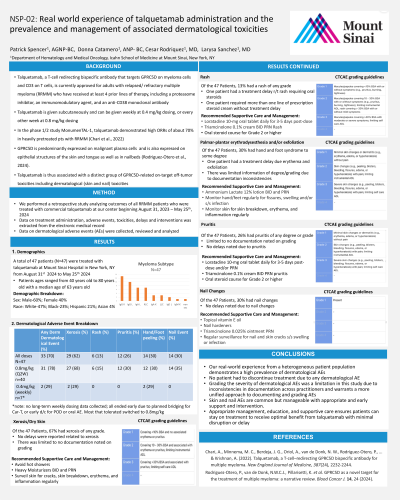Nursing Symposium
Poster Session 2
NSP-02: Real world experience of talquetamab administration and the prevalence and management of associated dermatological toxicities
Thursday, September 26, 2024
Location: Exhibit Hall, Pavilion 3


Patrick Spencer, NP (he/him/his)
Multiple Myeloma Nurse Practitioner
Mount Sinai Hospital
Astoria, New York, United States
Introduction: Talquetamab is a T-cell redirecting bispecific antibody that targets a novel antigen, GPRC5D, on myeloma cells and CD3 on T cells. Data from the MonumenTAL-1 study in patients with relapsed/refractory multiple myeloma (RRMM) support efficacy of talquetamab with overall response rates >71%. Talquetamab is associated with a distinct group of GPRC5D-related adverse events (AEs) including dermatologic (skin and nail) AEs. Here we describe the presentation and management of dermatologic AEs in patients treated at a single center.
Methods: This retrospective study analyzed data from all RRMM patients who were treated with commercial talquetamab at our center beginning August 31, 2023. Patients who received talquetamab as a part their therapy were identified through the pharmacy’s database. Data was abstracted from Learn more about electronic medical records from ScienceDirect's AI-generated Topic Pages. electronic medical records and data on treatment administration, disease profiles, and toxicities were collected.
Results: As of May 25, 2024, data from 47 patients was analyzed. Patient race consisted of 47% White, 38% Black and Hispanic, and 4% Asian. Overall, 70% of patients experienced at least one dermatological AE. Skin related AEs were further evaluated into hand/foot exfoliation, pruritus, and dryness. Among patients with skin related AEs, 62% of patients experienced any grade dryness, 26% pruritus, and 30% hand/foot exfoliation. Thirty percent of patients experienced a nail event. No patients discontinued treatment due to dermatological AEs. Management of dermatologic AEs included use of a heavy moisturizer for general dryness; ammonium lactate 12% lotion twice daily (BID) for hand and foot peeling; loratadine 10-mg oral tablet daily for 3-5 days post-dose and triamcinolone 0.1% cream BID for pruritus, injection site reaction, and rash; and use of nail hardeners, topical vitamin E oil, and triamcinolone 0.025% ointment for nail thinning and peeling.
Conclusions: Our real world experience from a heterogeneous patient population demonstrates a high prevalence of dermatological AEs. Grading the severity of dermatological AEs was a limitation in this study due to inconsistencies in documentation across practitioners and warrants a more unified approach to documenting and grading AEs. Talquetamab is an effective therapy for patients with RRMM. Skin and nail AEs are common but manageable with no discontinuations at our institution. Appropriate management, education, and supportive care ensures patients can stay on treatment to receive optimal benefit from talquetamab.
Methods: This retrospective study analyzed data from all RRMM patients who were treated with commercial talquetamab at our center beginning August 31, 2023. Patients who received talquetamab as a part their therapy were identified through the pharmacy’s database. Data was abstracted from Learn more about electronic medical records from ScienceDirect's AI-generated Topic Pages. electronic medical records and data on treatment administration, disease profiles, and toxicities were collected.
Results: As of May 25, 2024, data from 47 patients was analyzed. Patient race consisted of 47% White, 38% Black and Hispanic, and 4% Asian. Overall, 70% of patients experienced at least one dermatological AE. Skin related AEs were further evaluated into hand/foot exfoliation, pruritus, and dryness. Among patients with skin related AEs, 62% of patients experienced any grade dryness, 26% pruritus, and 30% hand/foot exfoliation. Thirty percent of patients experienced a nail event. No patients discontinued treatment due to dermatological AEs. Management of dermatologic AEs included use of a heavy moisturizer for general dryness; ammonium lactate 12% lotion twice daily (BID) for hand and foot peeling; loratadine 10-mg oral tablet daily for 3-5 days post-dose and triamcinolone 0.1% cream BID for pruritus, injection site reaction, and rash; and use of nail hardeners, topical vitamin E oil, and triamcinolone 0.025% ointment for nail thinning and peeling.
Conclusions: Our real world experience from a heterogeneous patient population demonstrates a high prevalence of dermatological AEs. Grading the severity of dermatological AEs was a limitation in this study due to inconsistencies in documentation across practitioners and warrants a more unified approach to documenting and grading AEs. Talquetamab is an effective therapy for patients with RRMM. Skin and nail AEs are common but manageable with no discontinuations at our institution. Appropriate management, education, and supportive care ensures patients can stay on treatment to receive optimal benefit from talquetamab.